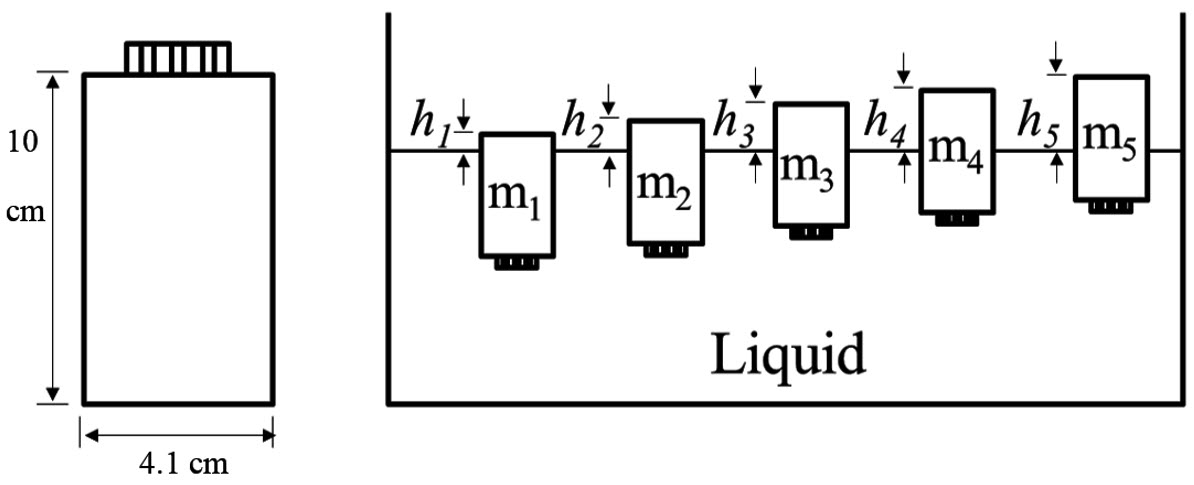ชุดกิจกรรมวิทยาศาสตร์ทางเลือกสำหรับหาความหนาแน่นของของเหลวด้วยหลักการของอาร์คิมิดีส
Main Article Content
Abstract
An Alternative Science Kit for Finding the Liquid Density Based on Archimedes' Principle
Ekkaphop Ketsombun and Tula Jutarosaga
รับบทความ: 10 พฤศจืกายน 2558; ยอมรับตีพิมพ์: 18 มีนาคม 2559
บทคัดย่อ
บทความนี้นำเสนอการพัฒนาชุดอุปกรณ์ทดลองอย่างง่าย สำหรับการคำนวณค่าความหนาแน่นของของเหลวจากมวลและปริมาตรของวัตถุที่ลอยอยู่ในของเหลว โดยอาศัยหลักการของอาร์คิมิดีส ชุดทดลองประกอบด้วยขวดทรงกระบอกจำนวน 5 ชิ้น ที่มีปริมาตรเท่ากันบรรจุทรายที่มีมวลแตกต่างกัน และมีความหนาแน่นน้อยกว่าของเหลวที่ต้องการระบุความหนาแน่น โดยการนำวัตถุนี้ไปลอยในของเหลว และบันทึกความสูงของวัตถุส่วนที่ลอยเหนือของเหลว จากนั้นเขียนกราฟความสัมพันธ์ระหว่างความสูงของวัตถุที่อยู่เหนือของเหลวในแกน y และมวลของวัตถุที่ลอยอยู่ในน้ำในแกน x ตามลำดับ ค่าความหนาแน่นของของเหลวและปริมาตรของวัตถุสามารถคำนวณได้จากค่าความชันและค่าจุดตัดบนแกน y ชุดอุปกรณ์ได้ถูกนำไปทดลองสอนนักเรียนชั้นมัธยมศึกษาปีที่ 6 ที่ต้องปรับพื้นฐานก่อนเข้าศึกษาต่อในระดับปริญญาตรีชั้นปีที่ 1 จำนวน 9 คนพบว่าคะแนนหลังเรียนมีค่าเพิ่มขึ้นภายหลังจากการใช้ชุดการทดลอง ซึ่งแสดงให้เห็นว่านักเรียนมีความเข้าใจเรื่องแรงลอยตัวเพิ่มขึ้น คาดว่าชุดกิจกรรมวิทยาศาสตร์อย่างง่ายชุดนี้จะสามารถในไปประยุกต์ใช้ในการจัดการเรียนการสอนเรื่องการลอยตัว และสมการเชิงเส้นสำหรับนักเรียนในระดับมัธยมศึกษาได้
คำสำคัญ: ความหนาแน่น แรงลอยตัว อาร์คิมิดีส ชุดกิจกรรมวิทยาศาสตร์
Abstract
A simple experimental setup for finding the liquid density with known mass and volume of floating objects using Archimedes’ was developed as a teaching tool for Archimedes’ Principle. The instrumentation consists of a set of 5 similar-volume cylindrical bottles filled with sand with different masses whose overall densities are less than the liquid whose density needed to be identified. By floating that series of objects in an unknown liquid, the height of object above liquid was recorded. When plot the height of object above liquid (y-axis) versus the mass of floating object (x-axis), the absolute liquid density and the volume of a set of objects could be calculated from the slope and the intercept on y-axis, respectively. Pre-test and post-test were performed before and after using the teaching tool for a small group of 9 high school students in the preparation course before becoming undergraduate students. The improvement of post-test score indicated the understanding of buoyancy of the students. This simple teaching kit can be adapted for the teaching of buoyancy and linear equation for students in the secondary school.
Keywords: Density, Buoyant force, Archimedes’ principle, Science kit
รับบทความ: 10 พฤศจิกายน 2558 ยอมรับตีพิมพ์: 18 มีนาคม 2559
Ekkaphop Ketsombun and Tula Jutarosaga
รับบทความ: 10 พฤศจืกายน 2558; ยอมรับตีพิมพ์: 18 มีนาคม 2559
บทคัดย่อ
บทความนี้นำเสนอการพัฒนาชุดอุปกรณ์ทดลองอย่างง่าย สำหรับการคำนวณค่าความหนาแน่นของของเหลวจากมวลและปริมาตรของวัตถุที่ลอยอยู่ในของเหลว โดยอาศัยหลักการของอาร์คิมิดีส ชุดทดลองประกอบด้วยขวดทรงกระบอกจำนวน 5 ชิ้น ที่มีปริมาตรเท่ากันบรรจุทรายที่มีมวลแตกต่างกัน และมีความหนาแน่นน้อยกว่าของเหลวที่ต้องการระบุความหนาแน่น โดยการนำวัตถุนี้ไปลอยในของเหลว และบันทึกความสูงของวัตถุส่วนที่ลอยเหนือของเหลว จากนั้นเขียนกราฟความสัมพันธ์ระหว่างความสูงของวัตถุที่อยู่เหนือของเหลวในแกน y และมวลของวัตถุที่ลอยอยู่ในน้ำในแกน x ตามลำดับ ค่าความหนาแน่นของของเหลวและปริมาตรของวัตถุสามารถคำนวณได้จากค่าความชันและค่าจุดตัดบนแกน y ชุดอุปกรณ์ได้ถูกนำไปทดลองสอนนักเรียนชั้นมัธยมศึกษาปีที่ 6 ที่ต้องปรับพื้นฐานก่อนเข้าศึกษาต่อในระดับปริญญาตรีชั้นปีที่ 1 จำนวน 9 คนพบว่าคะแนนหลังเรียนมีค่าเพิ่มขึ้นภายหลังจากการใช้ชุดการทดลอง ซึ่งแสดงให้เห็นว่านักเรียนมีความเข้าใจเรื่องแรงลอยตัวเพิ่มขึ้น คาดว่าชุดกิจกรรมวิทยาศาสตร์อย่างง่ายชุดนี้จะสามารถในไปประยุกต์ใช้ในการจัดการเรียนการสอนเรื่องการลอยตัว และสมการเชิงเส้นสำหรับนักเรียนในระดับมัธยมศึกษาได้
คำสำคัญ: ความหนาแน่น แรงลอยตัว อาร์คิมิดีส ชุดกิจกรรมวิทยาศาสตร์
Abstract
A simple experimental setup for finding the liquid density with known mass and volume of floating objects using Archimedes’ was developed as a teaching tool for Archimedes’ Principle. The instrumentation consists of a set of 5 similar-volume cylindrical bottles filled with sand with different masses whose overall densities are less than the liquid whose density needed to be identified. By floating that series of objects in an unknown liquid, the height of object above liquid was recorded. When plot the height of object above liquid (y-axis) versus the mass of floating object (x-axis), the absolute liquid density and the volume of a set of objects could be calculated from the slope and the intercept on y-axis, respectively. Pre-test and post-test were performed before and after using the teaching tool for a small group of 9 high school students in the preparation course before becoming undergraduate students. The improvement of post-test score indicated the understanding of buoyancy of the students. This simple teaching kit can be adapted for the teaching of buoyancy and linear equation for students in the secondary school.
Keywords: Density, Buoyant force, Archimedes’ principle, Science kit
รับบทความ: 10 พฤศจิกายน 2558 ยอมรับตีพิมพ์: 18 มีนาคม 2559
Downloads
Download data is not yet available.
Article Details
How to Cite
Ketsombun, E., & Jutarosaga, T. (2016). ชุดกิจกรรมวิทยาศาสตร์ทางเลือกสำหรับหาความหนาแน่นของของเหลวด้วยหลักการของอาร์คิมิดีส. วารสารหน่วยวิจัยวิทยาศาสตร์ เทคโนโลยี และสิ่งแวดล้อมเพื่อการเรียนรู้ (Journal of Research Unit on Science, Technology and Environment for Learning), 7(1), 204–211. https://doi.org/10.14456/jstel.2016.15
Section
บทความวิจัยการทดลองในชั้นเรียน (Classroom Laboratory Research Article)

This work is licensed under a Creative Commons Attribution-NonCommercial 4.0 International License.
References
Chattopadhyay, K. N. (2008). Finding the density of a liquid using a metre rule. Physics Education 43: 203–205.
Hughes, S. W. (2006). Measuring liquid density using Archimedes principle. Physics Education 41: 445–447.
Kireš M. (2007). Archimedes’ principle in action. Physics Education 42: 484–487.
Kulkarni A., Kim Y., and Kim T. (2009). A novel approach to the sensing of liquid density using a plastic optical fibre cantilever beam. Physics Education 44: 65–69.
Mumba F., and Tsige M. (2007). Finding the density of objects without measuring mass and volume. Physics Education 42: 293–295.
